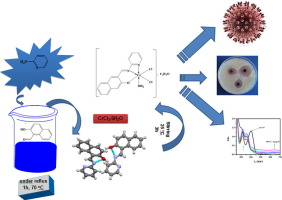To estimate the biological preference of synthetic small drugs towards DNA target, new metal based chemotherapeutic agents of nano-sized Cr(III), Fe(II), Co(II) and Ni(II) Schiff base complexes having N,N,O donor system were synthesized and thoroughly characterized by physic-chemical techniques. The redox behavior of the Cr(III), Fe(II) and Co(II) complex was investigated by electrochemical method using cyclic voltammetry. IR results proven that the tridentate binding of Schiff base ligand with metal center during complexation reflects the proposed structure. Magnetic and spectroscopic data give support to octahedral geometry for Cr(III) and Fe(II) complexes and tetrahedral geometry for Ni(II) and Co(II) complexes. The activation thermodynamic parameters, such as, E⁎, ΔH⁎, ΔS⁎ and ΔG⁎ are calculated using Coats–Redfern method by analyzing the TGA data. The particle size of the investigated metal complexes was estimated by TEM. In addition to, the interaction of the nanosized complexes with CT-DNA was estimated by electronic absorption, viscosity and gel electrophoresis. These techniques revealed that the complexes could bind to CT-DNA through intercalation mode. Moreover, the in vitrocytotoxic and antiviral activities of the nanosized complexes were checked against Herpes Simplex virus and Tobacco Mosaic viruses. Moreover, investigation of antioxidant activities of the new nanosized compounds was done by ABTS assay. Among the compounds tested, Fe(II) complex showed the strongest potent radical scavenging activity with percent of 58.60%. Furthermore, the antimicrobial bustle of the prepared compounds was screened against different types of bacteria and fungi and the results show that all metal complexes have superior activity than its free ligand.



